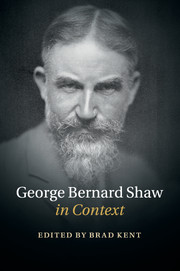Book contents
- Frontmatter
- Dedication
- Contents
- List of illustrations
- Notes on contributors
- Preface
- Acknowledgements
- A Chronology of Shaw's Works
- List of abbreviations
- PART I PEOPLE AND PLACES
- PART II THEATRE
- PART III WRITING AND THE ARTS
- 15 Cinema
- 16 Journalism
- 17 Letters
- 18 Media and technology
- 19 Modernism
- 20 Music
- 21 Novels
- 22 Publishers and publishing
- 23 Visual arts
- PART IV POLITICS
- PART V CULTURE AND SOCIETY
- PART VI RECEPTION AND AFTERLIFE
- Further reading
- Index
- References
22 - Publishers and publishing
from PART III - WRITING AND THE ARTS
Published online by Cambridge University Press: 05 October 2015
- Frontmatter
- Dedication
- Contents
- List of illustrations
- Notes on contributors
- Preface
- Acknowledgements
- A Chronology of Shaw's Works
- List of abbreviations
- PART I PEOPLE AND PLACES
- PART II THEATRE
- PART III WRITING AND THE ARTS
- 15 Cinema
- 16 Journalism
- 17 Letters
- 18 Media and technology
- 19 Modernism
- 20 Music
- 21 Novels
- 22 Publishers and publishing
- 23 Visual arts
- PART IV POLITICS
- PART V CULTURE AND SOCIETY
- PART VI RECEPTION AND AFTERLIFE
- Further reading
- Index
- References
Summary
‘I always tell young authors who consult me’, Bernard Shaw wrote to publisher Stanley Unwin in 1929, ‘that publishing is a gamble in which the publisher, who must make one best-seller pay for several duds, must take every advantage he can obtain, and that it is up to the author to take care of himself ’. Shaw spoke from experience: fifty years earlier, few publishers were willing to gamble on his novels, written one per year from 1879 to 1883 with workmanlike regularity. As one rejection letter followed the other, and realising that novels were not his forte, Shaw turned to political activism, journalism, and playwriting. His first play, Widowers’ Houses, begun in 1884, was completed in October 1892 and published by Henry & Co. the following year. It sold poorly. ‘I object to publishers’, Shaw groused to bookseller Frederick H. Evans on 14 August 1895. ‘They combine commercial rascality with artistic touchiness and pettishness, without being either good business men or fine judges of literature. All that is necessary to the production of a book is an author and a bookseller, without any intermediary parasite’.
Although Shaw would perennially berate his publishers for their ineffectuality and incompetence, his close ties with publishing house presidents, directors, managers, and agents would prove crucial to his literary and economic success. In dealing with his five primary publishers – Grant Richards, Constable, and Penguin in England; Brentano's and Dodd, Mead in the United States – Shaw tried to control the fate of his books from proofs to bookshop, and to have the last word on prices, advertising, copyright, and royalties, on typeface, type size, margins, paper, and binding. Given his myriad activities – from writing and lecturing to directing and travelling – Shaw's micro-management of the technicalities and legalities involved in publishing his works is astonishing. He rewrote contracts, outlined more effective advertising strategies, and took precautions to ensure airtight agreements. Publishing was a gamble, but Shaw was no gambler.
Moreover, publishing plays was a risky business. Playtexts were bought mostly as inexpensive keepsakes of performances, and printed drama was overshadowed by triple-decker novels (until 1894, with the introduction of the one-volume, six-shilling format). There were also legal impediments to publishing plays.
- Type
- Chapter
- Information
- George Bernard Shaw in Context , pp. 175 - 182Publisher: Cambridge University PressPrint publication year: 2015



